Shikoku
The more rural side of Japan
Use the navigation bar on the left or the map-links to select a place. Alternatively scroll down to see all the entries. Click on photos to enlarge. See more Shikoku photos here.
Kochi
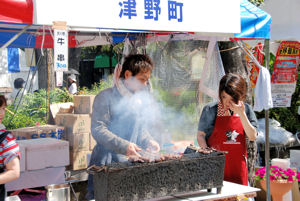 I started my trip around the island of Shikoku in the southern coastal city of Kochi. I arrived in the early evening having travelled from Tokyo via the shinkansen network as far as Okayama, then on the local network across Sikoku itself. Again it was Golden Week, when most Japanese people take their leave, and so I was slightly worried about finding accommodation for this trip. I was therefore pleased to see a 'Super Hotel' - a business hotel chain - as I pulled into the station. These are standard business hotels but are cheap, clean and have air conditioning, free breakfast and often a hot spring as well, so are indeed super. I booked in for two nights then headed straight back to the station to find the tourist information centre. I had planned to visit the Iya valley, a more remote region in the centre of the island, and having passed it on the train down I knew it was as impressive as the guide made out. Learning from previous errors I also knew that accommodation might prove tricky so though I should try to book quickly -
I started my trip around the island of Shikoku in the southern coastal city of Kochi. I arrived in the early evening having travelled from Tokyo via the shinkansen network as far as Okayama, then on the local network across Sikoku itself. Again it was Golden Week, when most Japanese people take their leave, and so I was slightly worried about finding accommodation for this trip. I was therefore pleased to see a 'Super Hotel' - a business hotel chain - as I pulled into the station. These are standard business hotels but are cheap, clean and have air conditioning, free breakfast and often a hot spring as well, so are indeed super. I booked in for two nights then headed straight back to the station to find the tourist information centre. I had planned to visit the Iya valley, a more remote region in the centre of the island, and having passed it on the train down I knew it was as impressive as the guide made out. Learning from previous errors I also knew that accommodation might prove tricky so though I should try to book quickly - 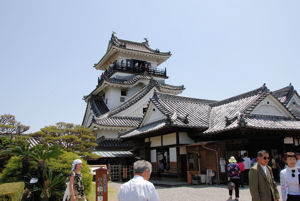 I don't like advanced bookings as it pins one's plans rather, but I equally didn't want to miss out on seeing this area. The girl in the office was very helpful, even after closing time arrived and we still hadn't finished, and I was pleased that my Japanese was up to being able to negotiate all the tricky variations. I had left travelling Shikoku until near the end of my stay in Japan to improve my language skill as I had read English was not widely spoken, and the trip was far more enjoyable for being able to chat to the locals and efficiently organise stuff like this.
I don't like advanced bookings as it pins one's plans rather, but I equally didn't want to miss out on seeing this area. The girl in the office was very helpful, even after closing time arrived and we still hadn't finished, and I was pleased that my Japanese was up to being able to negotiate all the tricky variations. I had left travelling Shikoku until near the end of my stay in Japan to improve my language skill as I had read English was not widely spoken, and the trip was far more enjoyable for being able to chat to the locals and efficiently organise stuff like this.Having thus organised half of my week I headed into the centre of Kochi for a look around. Being further south Shikoku has a much more tropical feel to it, with temperatures in the high twenties and moderate humidity, so it seems more like South East Asia than the semi European climate of Hokkaido.
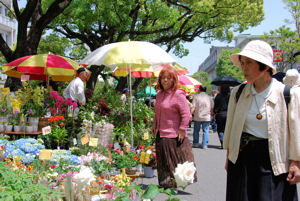 There were lots of sushi restaurant in the middle of town so I went for a tuna and rice dish then wandered the city a little more.
There were lots of sushi restaurant in the middle of town so I went for a tuna and rice dish then wandered the city a little more.
The following day I had planned to head all the way to the southern most point of the island to the area of Ashizuri Masaki. After an early start I thought I'd get some cash then catch the first train. At the station one of the girls at the information desk was very enthusiastic in trying to help me book tickets, and was a little disappointed that I had already managed on my own. However, I was quickly back to get her help when I discovered none of the cash points would accept my card. After a quick phone call to the head office she got one to work for me, thank goodness, but this extra time meant I missed the train by five minutes and so had to wait 2 hours for the next one. To fill the time I wandered back the city centre where the Golden Week festivities were starting to kick off.
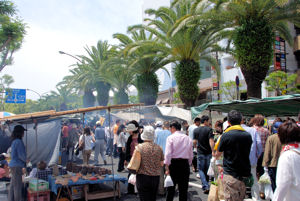 There was music and lots of food mixed
There was music and lots of food mixedwith the tropical warmth, and made for a fine way to pass the time waiting for the train to take me on to Nakamura.
The following day I went to look at Kochi castle, one of the oldest Japanese castles I've seen as it has remarkable not burned down for the last 250 years (one building is around 500 years old apparently). The castle was nice enough but the grounds were really pleasant. On the way back into town I wander through the street market that happens every Sunday. This had a traditional feel to it with many of the stalls selling fruit, vegetables and flower, and only a few given over to tourist paraphernalia. Most of the stall holders were quite old, which was something I noticed a lot during the trip - there is more of a traditional feel to the island, but only the older generation seem to have maintained this so I can't see it lasting for so much longer. After lunch I caught an express bus across Shikoku to the city of Matsuyama.
Nakamura
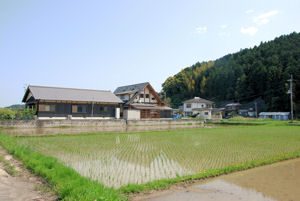 There is very little to the town of Nakamura itself, but it sits in an area of countryside and is surrounded by rice paddies. It also boasts the last free flowing river in Japan. Amazingly all streams and rivers in this country have been dammed and the river bottoms concreted over to control their flow. I'm not sure why this has been done exactly, but it was nice to see a full size river with trees on the banks. I arrived around lunchtime and given the small range of options I headed to a noodle shop next to the station. I was greeted by the elderly owner who tried to dissuade me from coming in - not an uncommon happening - but after a few polite words she realised I could speak a little of the language and so was happy to serve me, sometime people worry they won't be able to understand a foreigner so are not so happy about serving you. Inside I chatted with the owner and a customer at the counter and he told me the last train was returning around 3 pm.
There is very little to the town of Nakamura itself, but it sits in an area of countryside and is surrounded by rice paddies. It also boasts the last free flowing river in Japan. Amazingly all streams and rivers in this country have been dammed and the river bottoms concreted over to control their flow. I'm not sure why this has been done exactly, but it was nice to see a full size river with trees on the banks. I arrived around lunchtime and given the small range of options I headed to a noodle shop next to the station. I was greeted by the elderly owner who tried to dissuade me from coming in - not an uncommon happening - but after a few polite words she realised I could speak a little of the language and so was happy to serve me, sometime people worry they won't be able to understand a foreigner so are not so happy about serving you. Inside I chatted with the owner and a customer at the counter and he told me the last train was returning around 3 pm.
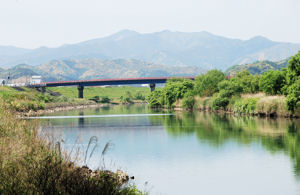 That only gave me an hour or so, and so I gave up my plan of trying to head further south and opted to just wander the river and look at the rice fields.
That only gave me an hour or so, and so I gave up my plan of trying to head further south and opted to just wander the river and look at the rice fields.I arrange to meet the other customer from the noodle shop, a middle aged man whose job was something medical related, on the train as he was heading to Tokyo that afternoon and was very excited about meeting an Englishman. It is times that this that I realise how lacking my language really is, as he wanted to discuss religion and customs with me, but I was largely unable to understand, so had to resort to a large amount of dictionary usage and general hand waving. He seems pleased enough though as kept saying I should go all the way to Tokyo with him or that he should accompany me to Kochi. This was slightly unnerving but I think he was just being polite.
Matsuyama
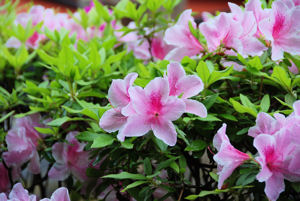 In my excitement at finding a cheap, good quality, hotel in Kochi I had asked the receptionist to book me into another one of their chain in Matsuyama. Looking at the little card it seemed the hotel was quite near the station so I rode the bus to the end of the line and collected my things. Unfortunately the map proved slightly misleading as the hotel was on the other side of the city centre and I was only able to work this out after walking nearly all the way there. But it was a nice day and it is always good to walk through the centre of a new city to learn where everything is located and see how the transport works - a nice thing about Shikoku cities is they often have a street tram network which is a convenient way of getting about as long as you know what stop you want.
In my excitement at finding a cheap, good quality, hotel in Kochi I had asked the receptionist to book me into another one of their chain in Matsuyama. Looking at the little card it seemed the hotel was quite near the station so I rode the bus to the end of the line and collected my things. Unfortunately the map proved slightly misleading as the hotel was on the other side of the city centre and I was only able to work this out after walking nearly all the way there. But it was a nice day and it is always good to walk through the centre of a new city to learn where everything is located and see how the transport works - a nice thing about Shikoku cities is they often have a street tram network which is a convenient way of getting about as long as you know what stop you want.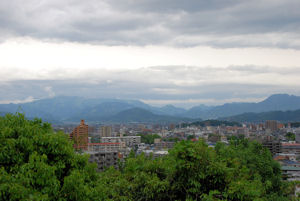 By the time I had checked in it was evening and I couldn't face going all the way back to the city centre so I wandered around the immediate vicinity, and then found a dumpling cafe for dinner. Again, this was a very local establishment and upon entering I was given what seemed like a disapproving look from the other customer. So I selected a table at the far end and read my book. But fairly soon the customer came over to chat and practice his English and I used the opportunity to find out a little about where to visit in Matsuyama. I'm not sure if it was the improved language or the people of Shikoku, but people everywhere were very friendly and a small thing like returning my plates to the counter brought forth the owner saying what gentlemen the British are, which was nice, and always pleases me.
By the time I had checked in it was evening and I couldn't face going all the way back to the city centre so I wandered around the immediate vicinity, and then found a dumpling cafe for dinner. Again, this was a very local establishment and upon entering I was given what seemed like a disapproving look from the other customer. So I selected a table at the far end and read my book. But fairly soon the customer came over to chat and practice his English and I used the opportunity to find out a little about where to visit in Matsuyama. I'm not sure if it was the improved language or the people of Shikoku, but people everywhere were very friendly and a small thing like returning my plates to the counter brought forth the owner saying what gentlemen the British are, which was nice, and always pleases me.The following day I headed over to the east side of the city where the Dogo Park and Onsen are located.
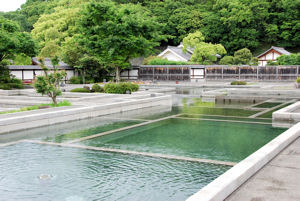 I first wandered around the park and met a guide who told me a bit about the area and showed me the way to get to the Ishite temple. Shikoku is most famous for the 88 sacred temples trail, which is an ancient pilgrimage around the edge of the island. My first plan had been to try to cover some of this route by bike, but having decided to also visit the islands interior, that didn't leave enough time to make a proper go of it. Therefore Isite-ji was my first sacred temple. Set in a woodland area away from the road, the old wooden building looked the part and the smell of incense was heavy in the air as pilgrims offered payers. The 88 temple trail is still a popular pilgrimage, although nowadays most people do it in stages, and since it was Golden week everywhere on the island was busy with people wearing the traditional white clothing and woven hats. I had a respectful look around then headed back to the road via the row of tourist shops spanning the track up to the temple complex itself. I then followed the road back to the park and on to the hot spring area of the town.
I first wandered around the park and met a guide who told me a bit about the area and showed me the way to get to the Ishite temple. Shikoku is most famous for the 88 sacred temples trail, which is an ancient pilgrimage around the edge of the island. My first plan had been to try to cover some of this route by bike, but having decided to also visit the islands interior, that didn't leave enough time to make a proper go of it. Therefore Isite-ji was my first sacred temple. Set in a woodland area away from the road, the old wooden building looked the part and the smell of incense was heavy in the air as pilgrims offered payers. The 88 temple trail is still a popular pilgrimage, although nowadays most people do it in stages, and since it was Golden week everywhere on the island was busy with people wearing the traditional white clothing and woven hats. I had a respectful look around then headed back to the road via the row of tourist shops spanning the track up to the temple complex itself. I then followed the road back to the park and on to the hot spring area of the town.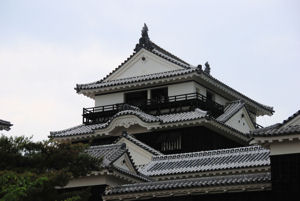 The Dogo Onsen is a very famous hot springs in Japan and is situated in a nicely styled old building. Again, since it was Golden Week, there were masses of people so went for coffee in the hope it would quieten down by lunchtime. Unfortunately, when I can back there was still a large queue so I gave up that idea and went to the bath house next door, which was also very grand, but not so famous it would seem. I had a quick meal of noodles and then headed over to see the castle situated on a hill right in the centre of town. Before climbing the hill I had a wander around a Ninomaru Shiseki Teien park. This is a very interesting area built on the foundation of an old outbuilding from the castle. The garden follows the lines of the old foundations but are built on the principle of wabi (taste for the simple and quiet) and sabi (elegant simplicity). My favourite part was the flowing water garden where a number of rectangular pools at different heights interconnect to allow water to flow between then.
The Dogo Onsen is a very famous hot springs in Japan and is situated in a nicely styled old building. Again, since it was Golden Week, there were masses of people so went for coffee in the hope it would quieten down by lunchtime. Unfortunately, when I can back there was still a large queue so I gave up that idea and went to the bath house next door, which was also very grand, but not so famous it would seem. I had a quick meal of noodles and then headed over to see the castle situated on a hill right in the centre of town. Before climbing the hill I had a wander around a Ninomaru Shiseki Teien park. This is a very interesting area built on the foundation of an old outbuilding from the castle. The garden follows the lines of the old foundations but are built on the principle of wabi (taste for the simple and quiet) and sabi (elegant simplicity). My favourite part was the flowing water garden where a number of rectangular pools at different heights interconnect to allow water to flow between then. 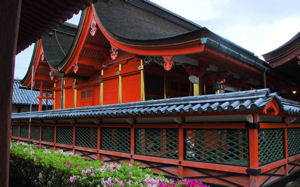 A short hike up the hill and I came to the castle itself with a commanding view of the area. I think this is the best Japanese castle I have seen so far, and is another original to have avoided being burned down. Inside, steep steps lead to top and each level has the usual variety of well constructed historical displays. Having walked enough for one day I decided to catch the gondola back to the bottom of the hill, but as soon as I got on I found out there was also a chairlift, which looked much more fun. Fortunately a couple of Japanese tourist had the same feeling so we asked to swap over to the lift. Back at the bottom I headed back to the Dogo Park to catch sunset before heading to the town centre for a meal and drink.
A short hike up the hill and I came to the castle itself with a commanding view of the area. I think this is the best Japanese castle I have seen so far, and is another original to have avoided being burned down. Inside, steep steps lead to top and each level has the usual variety of well constructed historical displays. Having walked enough for one day I decided to catch the gondola back to the bottom of the hill, but as soon as I got on I found out there was also a chairlift, which looked much more fun. Fortunately a couple of Japanese tourist had the same feeling so we asked to swap over to the lift. Back at the bottom I headed back to the Dogo Park to catch sunset before heading to the town centre for a meal and drink.The next morning I caught the train over to north coast city of Takamatsu. I sat next to a pilgrim who was on his way back to Osaka, having spent his holiday doing part of the trail. He was an earthquake engineer who had excellent English and told me about how only 20 years ago the heavily built up areas we were passing through was all fields and forests. Shikoku is one of Japan's last frontiers it would seem, and the development here has been a little slower than in the rest of the country. He was quite saddened by the destruction of the environment, which I could understand. However, as with most areas of Japan, all of the hills are still fully forested with no development whatsoever (they are too steep really), so it could be much worse. Mainly perhaps it is a shame that the development takes the form of fairly ugly buildings, although coming from the UK I'm used to this.
Takamatsu
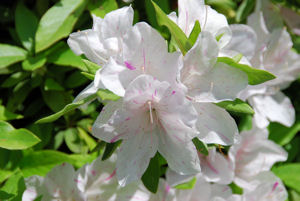 My booking in Nishi Iya was for the Wednesday and Thursday as the holiday period made the hotels rather expensive in this slightly exclusive area. This meant I had to structure my week in a slightly odd fashion so as to be able to get to Oboke early the next day, and so I found myself with only half a day to wander Takamatsu. Again I used the tourist office to find a hotel (after my experiences in other countries I have avoided any form of tourist centre due to commission charges and general feeling of trying to make money out of you, but in Japan, as I guess is the case also for many other countries, it does save a lot of hassle with no extra cost, although it does make things much simpler now being able to speak the language - they are, after all, set up for Japanese people).
I had a quick look around the park in the centre of town before catching a bus out to the large gardens on the outskirts known as Ritsurin koen.
This garden apparently took well over 100 years to complete and features a number of carefully planned lakes and streams and footpaths interconnected via a number of bridges.
My booking in Nishi Iya was for the Wednesday and Thursday as the holiday period made the hotels rather expensive in this slightly exclusive area. This meant I had to structure my week in a slightly odd fashion so as to be able to get to Oboke early the next day, and so I found myself with only half a day to wander Takamatsu. Again I used the tourist office to find a hotel (after my experiences in other countries I have avoided any form of tourist centre due to commission charges and general feeling of trying to make money out of you, but in Japan, as I guess is the case also for many other countries, it does save a lot of hassle with no extra cost, although it does make things much simpler now being able to speak the language - they are, after all, set up for Japanese people).
I had a quick look around the park in the centre of town before catching a bus out to the large gardens on the outskirts known as Ritsurin koen.
This garden apparently took well over 100 years to complete and features a number of carefully planned lakes and streams and footpaths interconnected via a number of bridges.
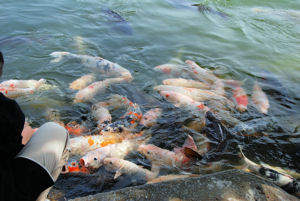 It took a few hours to walk around the whole area, so filled the rest of the afternoon. Not finding any particularly interesting eating options I went for a commercial izakaya and had a decent meal with lots of meat and rice - Shikoku is famous for its noodles and fish so I had mostly been eating these and enjoyed a change. I left Takamatsu early the next and headed back southwards into the island interior.
It took a few hours to walk around the whole area, so filled the rest of the afternoon. Not finding any particularly interesting eating options I went for a commercial izakaya and had a decent meal with lots of meat and rice - Shikoku is famous for its noodles and fish so I had mostly been eating these and enjoyed a change. I left Takamatsu early the next and headed back southwards into the island interior.
Iya Valley
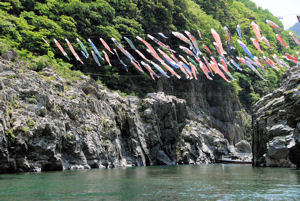 I arrived in Oboke mid morning and dumped my luggage in the station locker so I could have a look around. The town is situated on a river and is little more than a few houses and some tourist buildings. I was staying over in the next valley and had been told the hotel would pick me up when I phoned them so figured I would spend the morning here. It was very hot on this day and I was continuously reapplying sun cream to avoid getting burned in the direct sunlight. From the train I had noticed a large number of carp flags strung over the river, so headed back towards these on the main road. The whole of the Iya area is comprised of very steep hills separated by gorges, making for some really special scenery. The carp flags turned out to be situated at the main tourist centre, and from here I found I could also take a river cruse. This was nice, although I could only understand part of what the guide was saying, and gave me quite a relaxed morning.
I arrived in Oboke mid morning and dumped my luggage in the station locker so I could have a look around. The town is situated on a river and is little more than a few houses and some tourist buildings. I was staying over in the next valley and had been told the hotel would pick me up when I phoned them so figured I would spend the morning here. It was very hot on this day and I was continuously reapplying sun cream to avoid getting burned in the direct sunlight. From the train I had noticed a large number of carp flags strung over the river, so headed back towards these on the main road. The whole of the Iya area is comprised of very steep hills separated by gorges, making for some really special scenery. The carp flags turned out to be situated at the main tourist centre, and from here I found I could also take a river cruse. This was nice, although I could only understand part of what the guide was saying, and gave me quite a relaxed morning.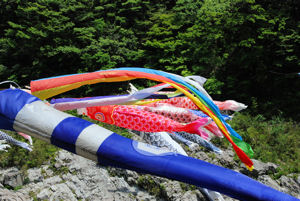 Back at the station I called up the hotel and was whisked over the pass and into the Iya valley in a private car and taken to my luxurious hot spring resort hotel. Since I hadn't booked lunch I headed straight out to walk the 3 Km over to the small town of Nishi Iya. I dined at a great soba restaurant on the way which was perched on the edge of a cliff, then headed into the town at the heart of the area dubbed as 'one of Japan's 3 hidden region'. Nowadays it is not so well hidden with a large new road and visitors centre carefully constructed out of concrete on a massive scaffold base. The river too has, of course, been dammed upstream and the river bed concreted over for some unknown reason (although when global warming really kicks in and water becomes in short supply this country will have an advantage). These are all very recent additions it would seem as every five minutes large trucks would drive past carrying rocks or concrete.
Back at the station I called up the hotel and was whisked over the pass and into the Iya valley in a private car and taken to my luxurious hot spring resort hotel. Since I hadn't booked lunch I headed straight out to walk the 3 Km over to the small town of Nishi Iya. I dined at a great soba restaurant on the way which was perched on the edge of a cliff, then headed into the town at the heart of the area dubbed as 'one of Japan's 3 hidden region'. Nowadays it is not so well hidden with a large new road and visitors centre carefully constructed out of concrete on a massive scaffold base. The river too has, of course, been dammed upstream and the river bed concreted over for some unknown reason (although when global warming really kicks in and water becomes in short supply this country will have an advantage). These are all very recent additions it would seem as every five minutes large trucks would drive past carrying rocks or concrete.
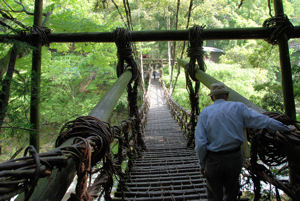 Thankfully, however, the development is of limited visibility, so the valley still looks quite appealing. One of the major attractions of the area is the vine bridges that span the rivers. In the past the region was inhabited by people fleeing persecution from the clans or governors on the mainland, and to keep themselves safe all the bridges were constructed out of vines which could be easily cut down should some unwelcome visitors arrive. This is now something of a tourist attraction and so I queued up along with an old couple to pay some money and cross the bridge. While the bridge itself now has cables hidden under the vines, the gaps between the sticks required some concentration and I was quite amazed that several couples, who I would guess to be over 80, were negotiating the bridge where one slight slip could easily result in a nasty accident - this is not a suing culture, I am quite sure nothing like this would be allowed in the UK, and in a way that's a shame as the triumphant looks on these couples faces afterwards was nice to see.
Thankfully, however, the development is of limited visibility, so the valley still looks quite appealing. One of the major attractions of the area is the vine bridges that span the rivers. In the past the region was inhabited by people fleeing persecution from the clans or governors on the mainland, and to keep themselves safe all the bridges were constructed out of vines which could be easily cut down should some unwelcome visitors arrive. This is now something of a tourist attraction and so I queued up along with an old couple to pay some money and cross the bridge. While the bridge itself now has cables hidden under the vines, the gaps between the sticks required some concentration and I was quite amazed that several couples, who I would guess to be over 80, were negotiating the bridge where one slight slip could easily result in a nasty accident - this is not a suing culture, I am quite sure nothing like this would be allowed in the UK, and in a way that's a shame as the triumphant looks on these couples faces afterwards was nice to see. 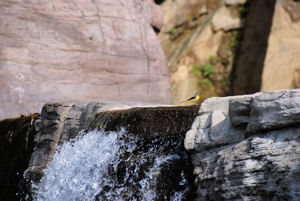 After wandering around the town some more I headed back to the hotel to enjoy the hot spring facilities and then have an excellent meal with many local delicacies.
After wandering around the town some more I headed back to the hotel to enjoy the hot spring facilities and then have an excellent meal with many local delicacies.The following day I planned to do a hike in the mountains, so took the first bus as far up the valley as I could. It was an amazing ride through some wonderful scenery and after an hour or so the bus terminated in a depot in an almost entirely deserted village. The only inhabitants seemed to be very old, and most were out working the fields. This was as far as I had been able to plan as the hotel had had no information about busses going further than this. Fortunately I had ridden the bus with a girl who was setting on a 2 day hike and so was prepared with all the necessary information. Also accompanied by a retired fireman we caught another bus as far as that would go and were left next to an empty house in the middle of nowhere.
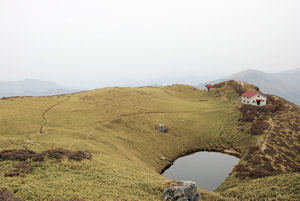
I had vaguely been thinking I would try to climb Tsurugi san, a famous mountain in the area, but this was still another 10 Km up the road and I only had 4 hours before the last bus was to leave. The only real option turned out to be climbing Muine san, the nearby mountain that the others were planning on doing. It took a good two hours to get to the top though some nicely forested hills, but the view from the top wasn't so spectacular as it was quite misty. While I had chatted a little with the other two on the way up we had all walked at different speeds so had not seem so much of each other, but on the way down I was caught up by fireman so we descended together. It was then that I was given perhaps the greatest compliment in my entire time in Japan when he asked me if I was Japanese. I had been struggling to understand most parts of the conversations on the way up but had tried to answer as much as possible, fortunately after he found out I was English he spoke slower so things were easier. It turned out he had recently quit his job and was travelling around Japan, mostly walking, to see some of his country. We kept up a strong pace and I made it back to the bus stop five minutes before the leaving time and was back in the hot spring by 6. Having seen about all there was to see in Iya I opted to leave early the next morning so I could visit Kotohira on my way back to Okayama.
Kotohira
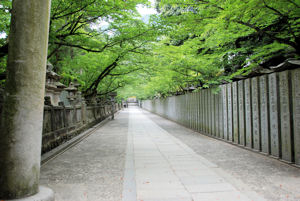 Kotohira is famous for the Kompira-san shrine, situated at the top of a large hill on the edge of town. Since I required no train connections to get here I arrived mid morning so though I would climb the hill before lunch. While not overly high, after the previous day's excursion I was quite tired by the time I reached the top. Again it was quite misty so the view was not so special but path meandered its way through the forested hillside and was dotted with shrines along the way, making it quite pleasant.
I had been told that the Kotohira Kabuki theatre was a very fine old building, so on my way back down tried to find it. I found one likely candidate, with was quite an impressive building, but I am not sure if it was the actual theatre. All the buildings in this part of town, however, were quite traditional, and the streets were too narrow for normal cars. Back at the station I found I only had ten minutes before the next train so ditched the idea of a nice lunch and grabbed some sushi from the convenience store before continuing on to Okayama.
Kotohira is famous for the Kompira-san shrine, situated at the top of a large hill on the edge of town. Since I required no train connections to get here I arrived mid morning so though I would climb the hill before lunch. While not overly high, after the previous day's excursion I was quite tired by the time I reached the top. Again it was quite misty so the view was not so special but path meandered its way through the forested hillside and was dotted with shrines along the way, making it quite pleasant.
I had been told that the Kotohira Kabuki theatre was a very fine old building, so on my way back down tried to find it. I found one likely candidate, with was quite an impressive building, but I am not sure if it was the actual theatre. All the buildings in this part of town, however, were quite traditional, and the streets were too narrow for normal cars. Back at the station I found I only had ten minutes before the next train so ditched the idea of a nice lunch and grabbed some sushi from the convenience store before continuing on to Okayama.
Okayama
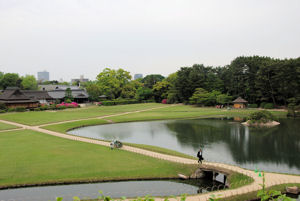 After checking the guide there seemed to be a cheap Ryokan near the station so I set off in that direction, however my feet were hurting quite a bit by this stage so after 100 meters I was lazy and checked into the nearby Tokyo Inn - a slightly more expensive option. I left my luggage then caught a tram over the Koraku-en gardens. These are said to be one of the three finest gardens in Japan, and, while quite small, are very precisely constructed. There are a number of themed gardens and a lake with a few small streams, as well as a few traditional buildings. I think I caught the gardens at the wrong time of year as there were very few flowers but many biting insects, so it wasn't the most stunning place I've visited. To escape the bugs I climbed the very tiny hill in the gardens centre, then spent ten minutes trying to explain the difference between Japanese and English estate gardens to a talkative Japanese person (in English). This was about the end of this trip, but Shikoku is a place I would like to return to at some point as it has a more traditional feel to it.
After checking the guide there seemed to be a cheap Ryokan near the station so I set off in that direction, however my feet were hurting quite a bit by this stage so after 100 meters I was lazy and checked into the nearby Tokyo Inn - a slightly more expensive option. I left my luggage then caught a tram over the Koraku-en gardens. These are said to be one of the three finest gardens in Japan, and, while quite small, are very precisely constructed. There are a number of themed gardens and a lake with a few small streams, as well as a few traditional buildings. I think I caught the gardens at the wrong time of year as there were very few flowers but many biting insects, so it wasn't the most stunning place I've visited. To escape the bugs I climbed the very tiny hill in the gardens centre, then spent ten minutes trying to explain the difference between Japanese and English estate gardens to a talkative Japanese person (in English). This was about the end of this trip, but Shikoku is a place I would like to return to at some point as it has a more traditional feel to it.